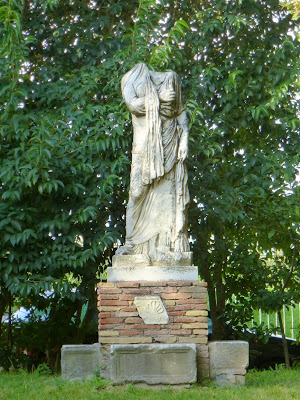We visited St. Peter's two or three times in 2011, and each time were thwarted by some religious observance--the nerve!!!--that closed the building off in the nave, even before the crossing. Each time we sat patiently in the area before Pope John XXIII (thinking of poor Anti-Pope John XXIII back in Florence), asking the marshals/wardens/whatever when the place might be open again, every time being told 5 minutes or 30 minutes or whatever, and then, hours later, giving up and leaving. This time we figured we'd sign up for the English language tour at the official Vatican Tourist Information office and would be escorted in by a prelate and given a real first-class tour and perhaps even some behind-the-scenes hocus-pocus. Maybe a minor miracle. Our tour guide, as it were, was a very nice and well-spoken seminarian, Stephen, hailing from Washington, DC, in his 2nd or 3rd year in the North American Pontifical Seminary or somesuch. Rather than walking right through security, however, we stood in line with everyone else while Stephen told us about Christianity, the history of Vatican City, St. Peter himself, the original St. Peter's, Julius II, Bramante, Michaelangelo, Bernini, the new building, and much else. For an hour. It was an hour well-spent, however, for he knew his stuff and fielded all our sometimes skeptical and irreverent questions very artfully. Not his first rodeo, evidently. Once inside, finally, we'd gotten only to the port transept when the barricade went up and all were shepherded back into the nave. We got to see a few more dead popes, both corrupt and incorrupt, corporeally, and finished up at the
Pieta. We thanked Stephen cordially and went back to Pope John XXIII to sit and wait. The marshals/wardens/whatever told us, variously, that the service would be over in 5 minutes, 45 minutes, or 6PM. I guess they are trained to say whatever is necessary to keep the tourists in line. Or possibly they don't know, aren't told, whatever. Perhaps no one knows. Much as I like Bernini and friends, I did not feel like another hour or two of waiting and uncertainty. And disappointment. We left. I took just a few photos since this time I was more into experiencing the thing apart from the camera lens and processor. Oh well.
 |
There, as you can see, people are being moved out of the
starboard transept to the left, then out of the port, and back
into the nave... |
 |
| Bernini's Throne of St. Peter |
 |
| Up closer |
 |
Bronze St. Peter; for centuries, pilgrims have
touched his right foot in order to earn time off
for good behavior; or maybe the opportunity to
see the rest of the building |
 |
| The very well-worn right foot... |
 |
Still the main attraction, however, Michaelangelo's
Pieta |
 |
Boys lined up to process into the great church; I admit to
having had very unkind thoughts seeing them, as we were
leaving... |
 |
But we'll let them pass, as the sun sets on yet another
unsuccessful visit to St. Peter's |


















































